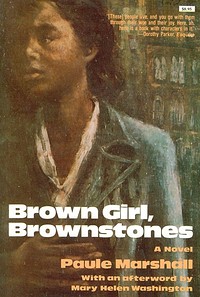Status
Genres
Publication
Description
Fiction. Literature. HTML: "An unforgettable novel, written with pride and anger, with rebellion and tears."�??Herald Tribune Book Review"Passionate, compelling . . . an impressive accomplishment."�??Saturday Review"Remarkable for its courage, its color, and its natural control."�??The New YorkerSelina's mother wants to stay in Brooklyn and earn enough money to buy a brownstone row house, but her father dreams only of returning to his island home. Torn between a romantic nostalgia for the past and a driving ambition for the future, Selina also faces the everyday burdens of poverty and racism. Written by and about an African-American woman, this coming-of-age story unfolds during the Depression and World War II. Its setting�??a close-knit community of immigrants from Barbados�??is drawn from the author's own experience, as are the lilting accents and vivid idioms of the characters' speech. Paule Marshall's 1959 novel was among the first to portray the inner life of a young female African-American, as well as depicting the cross-cultural conflict between West Indians and American blacks. It remains a vibrant, compelling tale of self-… (more)
User reviews
Brown Girl, Brownstones follows
The pages of Brown Girl, Brownstones fly by quickly, assisted by the realness of the characters' voices. I particularly enjoyed Marshall's use of Barbadian dialect, which helps to locate the novel in a particular time and place.
Brown Girl, Brownstones is an especially good choice for teenagers, but also for adults who are interested in stories set between the depression and the '50s.
Selina, as she grows up, becomes painfully aware of the power of white people over her and those who share her skin color.
Author Marshall has a power of imagery that lets the reader see Selina's world: the scenery, houses, neighborhoods, people, their clothes, their mannerisms, their attitudes. These are easily visualized for the reader and you will be the more engrossed in her work for this art.
Selina, at the age of 18, talking with her boyfriend of the scorn she feels for young members of the Barbados business association, which her mother wants her to join:
" 'I don't care, I won't be like them!' she replied savagely, and angrily struck the water with her foot so that the spray burst in a white design before them and then dropped. 'I won't be cut out of the same piece of cloth.' 'And most people want just that,' he offered, his eyes shrouded and aloof again, his voice bland. 'Because who wants to be out here alone? Who can take it? Most people want to be one with the lowering herd, to be told, to be led. They gladly hand over themselves to do something... ' " p.228
Selina, the star of her dance club, performed a solo at a dance recital. Afterwards, a huera who sang in the choir accompanying the recital, invited the members of the club to her house. The mother, jealous of Selina's spotlight, calls her away from the rest of the dancers for a talk:
"But when she looked up and saw her reflection in those pair of eyes, she knew that the woman saw one thing above all Else. Those eyes were a Well - lighted mirror in which, for the first time, Selena truly saw -- with a sharp and shattering clarity--the full meaning of her black skin.
"And knowing was like dying -- like being poised on the rim of time when the heart's simple rhythm is syncopated and then silenced and the blood chills and congeals, when a pall passes in the dark wind over the eyes. In that instant of death, false and fleeting though it was, she was beyond hurt. And then, as swiftly, terror flared behind her eyes, terror that somehow, in some way, this woman, the frightened girl at the door, those others dancing down the hall, even Rachel, all, everywhere, sought to rob her of her substance and herself. The thrust of hate at that moment was strong enough to sweep the world and consume them. What had brought her to this place? To the shattering knowledge? And obscurely she knew: the part of her which had long hated her for her blackness and thus begrudged her every small success like the one tonight..." P. 250
Running away from the party, Selina collapses sobbing in the doorway of a closed shop, and seeing her reflection in the window next to her, tries unsuccessfully to smash it:…
"She peered shyly at her reflection--the way a child looks at himself in the mirror. And, in a sense, it was a discovery for her also. She was seeing, clearly for the first time, the image which the woman--and the ones like the woman--saw when they looked at her. What Clive had said must be true. Her dark face must be confused in their minds with what they feared most: with the night, symbol of their ancient fears, which seethed with sin and Harbored violence, which spawned the beast in its fen; with the heart of darkness within them and all its horror and fascination. The woman, confronted by her brash face, had sensed the arid place within herself and had sought absolution in cruelty. Like the night, she was to be feared, spurned, purified -- and always reminded of her darkness..." p.251
"She cried because, like all her kinsmen, she must somehow prevent it from destroying her inside and find a way for her real face to emerge."p.252
